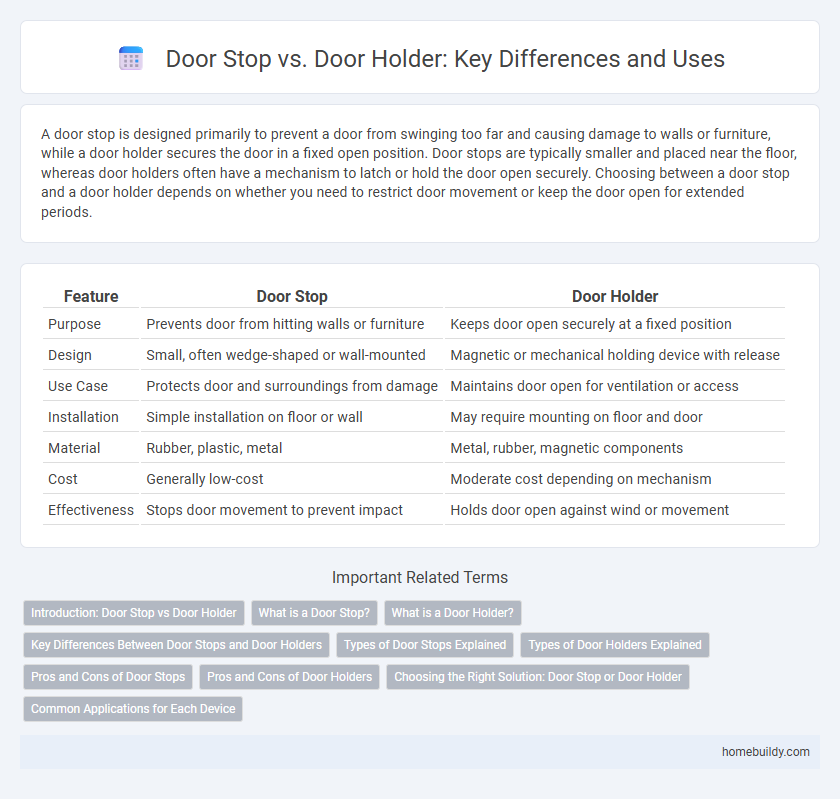A door stop is designed primarily to prevent a door from swinging too far and causing damage to walls or furniture, while a door holder secures the door in a fixed open position. Door stops are typically smaller and placed near the floor, whereas door holders often have a mechanism to latch or hold the door open securely. Choosing between a door stop and a door holder depends on whether you need to restrict door movement or keep the door open for extended periods.
Table of Comparison
| Feature | Door Stop | Door Holder |
|---|---|---|
| Purpose | Prevents door from hitting walls or furniture | Keeps door open securely at a fixed position |
| Design | Small, often wedge-shaped or wall-mounted | Magnetic or mechanical holding device with release |
| Use Case | Protects door and surroundings from damage | Maintains door open for ventilation or access |
| Installation | Simple installation on floor or wall | May require mounting on floor and door |
| Material | Rubber, plastic, metal | Metal, rubber, magnetic components |
| Cost | Generally low-cost | Moderate cost depending on mechanism |
| Effectiveness | Stops door movement to prevent impact | Holds door open against wind or movement |
Introduction: Door Stop vs Door Holder
A door stop is designed to prevent a door from hitting a wall or closing unintentionally, typically by securing the door at a fixed position on the floor or wall. In contrast, a door holder is intended to keep a door open in a specific position, often using a mechanical or magnetic mechanism that temporarily locks the door in place. Understanding the functional differences between door stops and door holders helps in selecting the appropriate hardware for safety, convenience, or building code compliance.
What is a Door Stop?
A door stop is a hardware device designed to prevent a door from opening too far and causing damage to walls or furniture. Unlike door holders, which keep a door fixed open, door stops are primarily used to limit the door's range of motion, often mounted on the floor, wall, or door itself. Common materials for door stops include rubber, metal, and plastic, chosen for durability and impact absorption.
What is a Door Holder?
A door holder is a device designed to keep doors securely open, preventing them from closing unintentionally, often using a magnetic or mechanical mechanism. Unlike a door stop, which primarily blocks a door from moving beyond a certain point, door holders actively maintain the door's position to allow easy passage or ventilation. Commonly installed in commercial or public buildings, door holders enhance safety and convenience by ensuring doors remain open when needed.
Key Differences Between Door Stops and Door Holders
Door stops are designed primarily to prevent doors from damaging walls by limiting their swing range, typically using materials like rubber or metal for cushioning impact. Door holders, on the other hand, secure doors in an open position, often featuring magnetic or mechanical components to hold the door firmly in place. Understanding these functional differences helps in selecting the appropriate device for controlling door movement and protection.
Types of Door Stops Explained
Door stops come in various types such as wall-mounted, floor-mounted, and hinge pin stops, each designed to prevent door damage by limiting movement. Door holders, in contrast, are intended to keep doors open securely, often using magnetic or mechanical mechanisms. Understanding the distinct functions and optimal applications of door stops and door holders ensures effective door control and protection in residential or commercial spaces.
Types of Door Holders Explained
Types of door holders include magnetic, hydraulic, and mechanical models, each designed to securely maintain doors in an open position. Magnetic door holders use powerful magnets to keep doors open, while hydraulic ones employ fluid pressure for smooth, adjustable control. Mechanical door holders, such as wedge or lever designs, rely on physical barriers to prevent door movement, offering simple and cost-effective solutions.
Pros and Cons of Door Stops
Door stops prevent doors from damaging walls by limiting their swing, offering a simple and cost-effective solution with minimal installation. They are versatile and discreet but may not hold a door open firmly in windy or busy environments. Unlike door holders, which secure doors in a fixed open position, door stops provide protection without altering door positioning, making them ideal for occasional use but less suited for hands-free door management.
Pros and Cons of Door Holders
Door holders provide the advantage of securely holding doors open for extended periods, making them ideal for high-traffic areas or situations requiring unobstructed access. However, door holders can pose safety risks by preventing doors from closing in emergencies, potentially violating fire safety regulations. Unlike door stops, door holders lack flexibility for temporary door positioning and may require manual release, limiting their convenience in dynamic environments.
Choosing the Right Solution: Door Stop or Door Holder
Choosing between a door stop and a door holder depends on the specific use case and environment. Door stops are ideal for preventing door damage by limiting swing range, while door holders securely fix doors in an open position for ventilation or accessibility. Understanding the functional differences and installation requirements ensures selecting the right solution for safety and convenience.
Common Applications for Each Device
Door stops are commonly used to prevent doors from damaging walls or furniture by limiting their swing, making them ideal for residential spaces and offices. Door holders are designed to keep doors open securely, often found in commercial buildings, hospitals, and schools where airflow or accessibility is important. Both devices enhance door functionality but serve distinct purposes based on the need to either restrict or maintain door position.
door stop vs door holder Infographic

 homebuildy.com
homebuildy.com